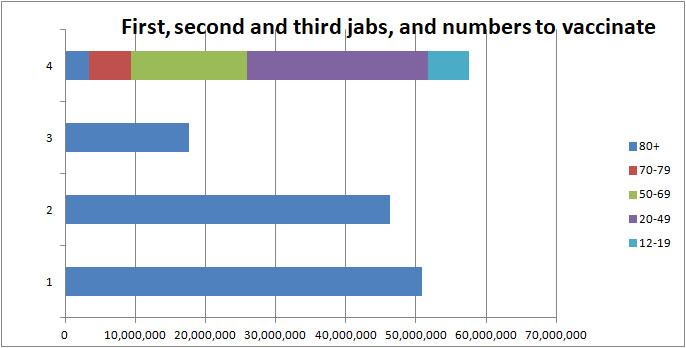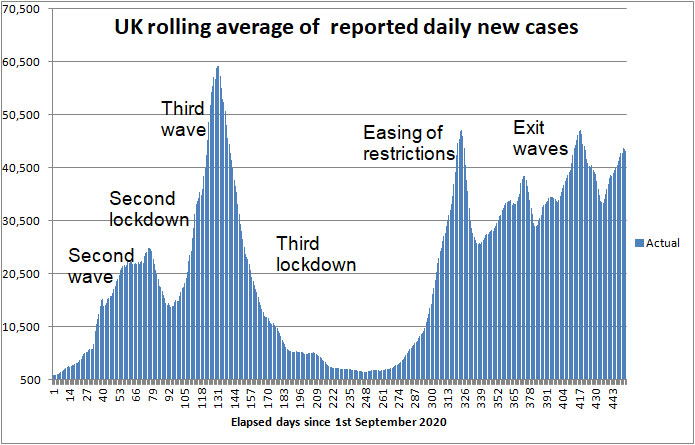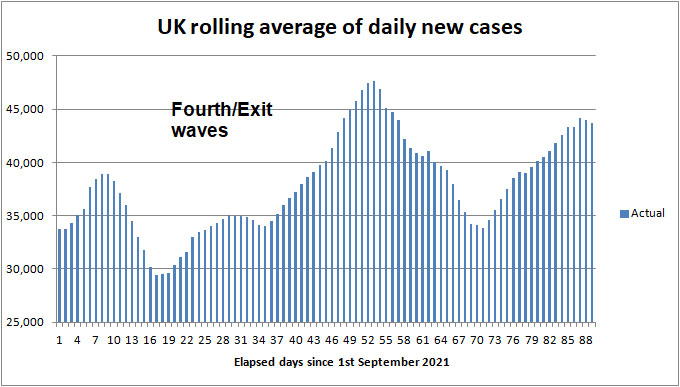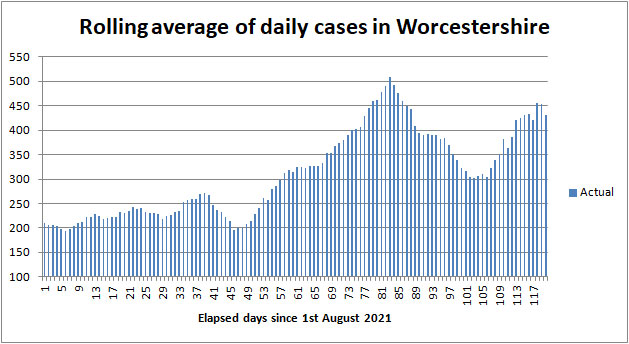
Angus and Rosemary's Miscellany
of Malvern - Other Resources
|
Coronavirus (COVID-19) epidemic weekly update for Malvern Seniors28th November 2021 GET VACCINATED AND TAKE CARE AS VIRUS STILL WIDESPREAD New variant of concern named Omicron Skip preamble and go to summary Skip to menu of archived pages PreambleWe keep an eye on the published government figures and monitor the media to asses the level of risk for Seniors in the Malvern Hills district. We also provide links to where further information can be found. This page is normally updated every Sunday between 1800 and 2400 hours GMT. Information about Coronavirus can be found on the NHS website: https://www.nhs.uk/coronavirus How to get vaccinatedThe most important thing everyone can do now is get vaccinated. Most Seniors should have been double jabbed months ago, but if not get your vaccine, and encourage your friends and loved ones to get theirs. The effectiveness of the vaccines falls over time so remember to get your booster shot six months after your second jab. You should get a reminder either from the NHS or your GP surgery; this could be by letter, or a text message if you have registered a mobile phone number. Boosters can now be had without an appointment at the Three Counties Show Ground. See the NHS website for opening times and vaccine availability: Alternatively, when the time comes, try booking an appointment at your GP surgery. Note: the immuno-suppressed may be offered a third jab as part of their primary course, followed by a booster later.
|
| Districts of Worcs | Cases | Weekly increase | Population |
| Bromsgrove | 16,023 | +495 | 98,529 |
| Malvern Hills | 7,759 | +368 | 77,545 |
| Redditch | 13,993 | +456 | 85,317 |
| Worcester | 14,304 | +664 | 103,542 |
| Wychavon | 16,015 | +653 | 126,240 |
| Wyre Forest | 13,946 | +388 | 100,957 |
| TOTAL | 82,040 | +3,024 | 592,130 |
| COMPARE WITH | |||
| County of Hereford | 21,983 | +685 | 195,000 |
| Leicester (city of) | 66,606 | +1,362 | 400,000 |
Cumulative cases reported by PHE in Worcestershire to 28th November 2021
During the last week daily cases remained broadly flat in Worcestershire and the city of Leicester; cases fell slightly in Herefordshire.
Note: the weekly increase is indicative; the seven day average by area, which varies day to day, is an alternative metric that can be found on the Coronavirus dashboard.
Cases in Malvern Hills by age group
On the cases tab of the Coronavirus dashboard you can either select the county of Worcestershire or a local authority such as the Malvern Hills, and there you can find a heat map showing cases by age group over time and a chart comparing the number of cases under 60 years with those aged 60+.
The latest figures show the infection rate in those aged 60+ years is 8 times lower and going down, compared to those below the age of 60, whilst the heat map shows since the autumn the infection rate has been highest in those of school age.
Click for cases by specimen date age demographics in the Malvern Hills
Interactive maps
At the bottom of the Coronavirus Dashboard (daily update) page there is an Interactive Map which is coloured to show infection rates across the country.
This week much of England and Wales turned purple reflecting the bump up in cases.
Click for Interactive Map of COVID cases
Note: the Interactive Map works on desktop PCs but it's possible you may encounter difficulties using a tablet or smartphone.
Recent weekly cases to 22nd November are: North Malvern 33; Malvern Link 25; Pickersleigh 27; Barnards Green 11; Malvern Wells and Priory 30; Callow End and Hanley 21; Upton and Welland 21.
Another map can be found on the Zoe COVID Study website indicating extrapolated cases based on reports from those using the Zoe app.
Click for People with COVID (estimated from the Zoe app)
Number of deaths
Statistics on COVID deaths are published by Public Health England, The Office of National Statistics, and NHS England.
PHE figures
Public Health England reports that the cumulative total of COVID (28) deaths in UK hospitals and care homes rose by 848 in the last week to 144,775 while the daily average fell from 147 to 121 deaths per day.
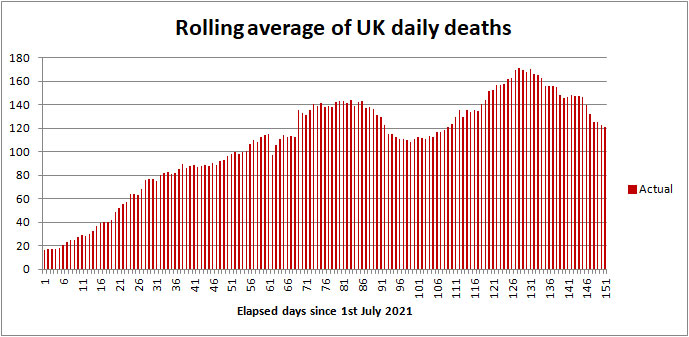
COVID-19 death rate 1st July to 28th November 2021
Click to view the UK government Coronavirus Dashboard
Since England emerged from lockdown on 19th July about 16,000 people have died of COVID-19; mostly the elderly.
In comparison averaged over recent years 1,700 people die daily from all causes, so COVID deaths now account for about 7%.
ONS figures
The Office of National Statistics (ONS) separately reports registered deaths in England and Wales where COVID-19 is mentioned on the death certificate. The ONS figures lag the PHE figures by 10 - 14 days and do not include Northern Ireland and Scotland.
Click for national ONS data on deaths (Excel spreadsheet)
The ONS figures are broken down by District providing a glimpse of where deaths are occurring. The provisional cumulative total of COVID related deaths in Worcestershire reported by the ONS up to 12th November 2021 (week 45 of 2021) is shown below.
Note: the numbers are from the ONS Death Registrations-Pivot table
| Districts of Worcs | Deaths 2020 |
Deaths 2021 |
Week 45 | Population |
| Bromsgrove | 164 | 127 | 4 | 98,529 |
| Malvern Hills | 61 | 93 | 2 | 77,545 |
| Redditch | 108 | 96 | 0 | 85,317 |
| Worcester | 87 | 127 | 1 | 103,542 |
| Wychavon | 157 | 146 | 1 | 126,240 |
| Wyre Forest | 171 | 125 | 0 | 100,957 |
| TOTAL | 748 | 714 | 8 | 592,130 |
Provisional cumulative COVID-19 deaths registered by ONS to 12th November 2021
In week 45 there were 2 deaths in a care home and 2 in hospital in Bromsgrove; 1 death in a care home and 1 at home in the Malvern Hills; 1 death in hospital in Worcester; and 1 death in a care home in Wychavon.
In England and Wales 1,018 COVID-19 related deaths were reported in the week to 12th November, just 28 more than the week before. Of these 69 were in a care home, 101 at home, 10 in a hospice, 832 in hospital and 6 elsewhere.
Note: summation of rows 9 to 339 of the ONS deaths Registrations-Pivot table.
The provisional UK COVID-19 death toll (as reported by PHE and ONS) for all weeks of the epidemic can be found on the Deaths tab of the Coronavirus Dashboard.
NHS England figures for Worcestershire
The table below shows latest COVID deaths in Worcestershire hospitals reported by NHS England on 26th November 2021.
| Worcestershire | Cumulative deaths | Past week |
| Acute hospitals | 884 | 6 |
| Care hospitals | 64 | 0 |
| TOTAL | 948 | 6 |
Click for NHS COVID-19 total announced deaths
Click for Summary of Malvern numbers on the Coronavirus dashboard
Risk of COVID-19 death by age band
NHS England provides an analysis of COVID-19 deaths in hospital in England and Wales by age band. Shown below is a breakdown of deaths for the period 1st August 2021 to 25th November 2021 when the daily death rate fell to 125.
| Age band | Number of deaths | % of deaths |
| 0 - 19 | 29 | 0.3 |
| 20 - 39 | 157 | 2 |
| 40 - 59 | 1,058 | 11 |
| 60 - 79 | 4,062 | 43 |
| 80+ | 4,134 | 44 |
Relative risk of COVID-19 death by age band
Those aged 60+ years account for 87% of deaths compared to 92% last year, but remember that due to vaccination the death rate as a proportion of new cases is five to ten times lower than in 2020.
The majority of these deaths are likely to be of the vaccine-hesitant, those with underlying conditions such as Diabetes, the frail, and those that are immuno-compromised. Pregnant mothers, the overweight and deprived individuals with a poor diet are also said to be at increased risk.
An NHS leaflet offered to patients being admitted to hospital suggests we are at higher risk of complications from COVID-19 infection if we have one or more of the following conditions:
-
Age over 70 or Male over 50;
-
Lung problems (including asthma, COPD, emphysema, bronchitis, bronchiectasis;
-
Heart disease
-
Diabetes
-
Chronic kidney disease
-
Liver disease (eg hepatitis, cirrhosis)
-
Brain or nerve problems (eg Parkinson's disease, motor neurone disease, multiple sclerosis, cerebral palsy)
-
You have a condition that increases the risk of infection
-
Take medication that affects the immune system, (eg steroids)
-
Very obese (BMI over 40)
-
Pregnancy
Some COVID deaths are of the fully vaccinated elderly, but remember that broadly speaking we are ten times more likely to die of something else; so don't be over-concerned.
Healthcare numbers
The UK government Coronavirus Dashboard includes important information about healthcare statistics.
| Hospital COVID cases (UK) | Number | Change since last week |
| Patients currently in hospital | 7,633 | -446 |
| Patients on ventilation | 925 | +2 |
| Patients admitted daily | 768 | -113 |
Headline summary of patients in hospital reported on 28th November 2021
Hospital admissions fell slightly for a third week. The number of hospital beds occupied by COVID patients is now about 19% of the peak last January.
 Worcestershire hospital beds
Worcestershire hospital beds
Tabulated figures for bed occupancy in Worcestershire Acute and Care hospitals can be found on the NHS England website.
Click for NHS England COVID-19 Hospital bed Activity
A summary can be found on the UK government Coronavirus Dashboard which reports on 27th November there were 58 COVID-19 patients occupying Worcestershire Acute Hospital beds, of which 5 were ventilated beds; roughly 21% of the peak experienced last January.
Between 15 November 2021 and 21 November 2021, 38 patients went into hospital with coronavirus. This shows an increase of 15.2% compared to the previous 7 days, but on average the number of occupied beds is remaining fairly level.
Note: Healthcare statistics can be found on the Healthcare tab of the UK Coronavirus Dashboard. At the top of the page where it says Healthcare in United Kingdom, click the drop down arrow to select Area Type as NHS Trusts, and Area Name as Worcester Acute Hospitals.
Click to view Worcester healthcare figures
Alternatively,
Click for Summary of Malvern numbers on the Coronavirus dashboard
Forecast for the week ahead
Trends suggest that during the next seven days (up to 5th December) the cumulative total of UK COVID-19 cases reported by PHE on the Coronavirus Dashboard could increase by 300,000 towards 10,447,000 with the 7 day rolling average of daily new cases hovering around 43,000.
In Worcestershire up to 3,000 new cases of COVID-19 can be expected, and 350 cases in the Malvern Hills district.
We estimate the number of UK COVID (28) deaths will increase by about 850 towards 145,600 during the 7 days ending 5th December 2021, with the average daily death rate hovering around 120 deaths per day. These are 'baked in' deaths of those already infected which cannot be avoided.
In the county of Worcestershire, assuming a 0.2% death rate, the 3,024 new cases this week may translate to 6 COVID deaths per week towards the end of December.
The rise in daily cases has been mostly among schoolchildren who won't be admitted to hospital, whereas daily cases are falling slightly in those aged 60+. Consequently we expect daily hospital admissions to remain fairly flat next week at about 750. Numbers may then fall a bit as boosters increase the resistance to infection of fully vaccinated Seniors.
Longer term outlook
The outlook beyond Christmas is unpredictable following the emergence of the highly infectious Omicron variant in Africa which could overtake Delta early in the New Year.
For the current scenario, based on the Delta variant remaining dominant and becoming endemic, we had been expecting to see a gradual downturn in daily hospital admissions and deaths during the next 3 months as those aged 40+ years received booster jabs, and children were either vaccinated or gained immunity following infection by COVID-19.
The timing of this was itself uncertain depending on the speed of the vaccine rollout and take-up; tag on a week or so for the vaccine to take effect, a further week for the increased resistance to infection to impact hospital admissions, and a further two weeks for this to be reflected in the number of daily deaths, then we were looking towards the end of December to see a marked improvement in the figures.
That would coincide with the Christmas and New Year holiday when the reporting of figures is likely to be delayed, so reliable estimates of trends might not be obtainable until early January.
The emergence of the Omicron variant of concern in Africa may not greatly affect the UK figures for hospitalisations and deaths in December but could affect trends in January and beyond.
The likely new scenario involves Omicron overtaking Delta and becoming dominant. In a couple of weeks or so scientists should have a better idea about the reproduction rate of Omicron, the severity of illness in different age groups, and the level of protection offered by the current vaccines.
Last week modelling from University College London had been suggesting the 7-day average of daily deaths of about 150 per day should fall slowly over the next weeks, reaching a minimum of about 25 per day in March 2022.
This and other models will need to be rerun once the outline parameters of the Omicron variant are known, and as they are refined.
Click for UCL Long-term forecasting of the COVID-19 epidemic
For a fixed level of vaccination, daily cases have been a signpost to whether daily hospital admissions and deaths are going to go up or down. Based on our heuristic 'rules of thumb' hospital admissions, and deaths during December were expected to follow daily cases very roughly in the ratio:
-
Hospital admissions 1:50 of daily cases reported by PHE, lagging by 8 days.
-
Deaths 1:300 of daily cases reported by PHE, lagging by about 20 days.
-
UK Hospital bed occupancy - one fifth of daily cases, lagging by up to a month.
As boosters are rolled out a gradual improvement in these ratios is anticipated in the next month or so, but thereafter the situation could change as the Omicron variant overtakes Delta.
Advice for Seniors
 Recently
there have been no more than 10 COVID related deaths per week in Worcestershire
which has a population of 600,000 so we judge the
risk of death for fully vaccinated
Seniors to be
fairly
LOW while the risk of Long COVID might be MODERATE;
see our annex and riskometer opposite.
Recently
there have been no more than 10 COVID related deaths per week in Worcestershire
which has a population of 600,000 so we judge the
risk of death for fully vaccinated
Seniors to be
fairly
LOW while the risk of Long COVID might be MODERATE;
see our annex and riskometer opposite.
Remember, if you are elderly, have not been vaccinated, and were to catch COVID there is a significant chance that you will either die or your long term health may be seriously damaged, so if you are able get both doses of your vaccine and your booster and continue to take care of yourself and those you love. Also encourage others to be vaccinated.
Click for our risk of death table (for those who have not been vaccinated)
Like Health Minister Sajid Javid and Sir Kier Starmer, it is quite possible, despite a second jab, for Seniors to become ill with COVID-19; some might have mild symptoms like a common cold or hay fever, while others could feel very poorly, but few except the frail, vulnerable, and unlucky will need to be admitted to hospital.
In these increasingly uncertain times the simple safeguards to remember are to:
-
book your booster dose when you are contacted by either your GP or the NHS; don't worry if you have to wait a week or two to get an appointment; two weeks after the booster most people should be well protected from the Delta variant and will likely have significant protection from Omicron.
-
wash your HANDS thoroughly, using soap and hot water, for 20 seconds, including after handling deliveries to your home, to kill virus picked up from contaminated surfaces see note 1;
-
wear a FACE covering when unavoidably near other people for example when shopping, in health-care settings, and when using public transport;
-
SPACE at least 2 metres from people you don't feel safe with see note 2;
-
preferably socialise with friends and other households outdoors in the FRESH AIR else, if you are indoors, either ventilate by keeping windows open as far as is practicable or put a HEPA air purifier in the room;
-
avoid crowded indoor settings and minimise TIME near strangers;
-
self-isolate and take a test if you feel unwell with cold or flu like symptoms; according to the Zoe COVID Study the current top five symptoms amongst the double vaccinated and children, in order of prevalence, are said to be headache (73%), runny nose (73%), sneezing (59%), sore throat (53%), and cough (49%), which are often hard to distinguish from a common cold - you might alternatively suffer from fever with a temperature of up to 103 deg F, and a reduction in sense of taste.
-
respect others and give them space.
Notes:
1) Wash your hands thoroughly before touching your face to avoid transferring virus from contaminated surfaces to your mouth, eyes and nose. If outdoors use an alcohol based hand gel.
2) Two metres is further than you think - roughly an arm and a walking stick away.
Annex to 28th November update
Commentary
This week
Cases of the Delta variant continue to bump along at a high level in the UK. Most of the increase this week has been in children, while cases in those aged 60+ have actually gone down a little, presumably because of the booster campaign and Seniors being more cautious.
Consequently it is likely the daily number of patients admitted to hospital, and daily deaths will either flat-line or trend downwards in the first half of December.
In comparison to the UK daily cases of Coronavirus have been rising quite sharply in Western Europe, for example in Austria, Belgium and the Netherlands; this may simply be due to restrictions being relaxed later than in the UK and may not be a cause for concern.
Much more worryingly on Wednesday the media reported a new variant of concern found in South Africa which has been named Omicron.
Dr Angelique Coetzee first spotted symptoms amongst her patients in the Gauteng province of South Africa about 18th November 2021. Scientists now have to evaluate the reproduction rate, potential for causing serious illness, and effectiveness of the present vaccines but it may be into the New Year before we know whether or not Omicron is something to worry about.
Click for BBC report - Covid: New variant classed 'of concern' and named Omicron
Initial reports suggest the Omicron variant spreads much more rapidly than Delta and the fear is that the virus is already seeded in Europe and could rapidly become dominant. Cases have already been found in Essex, London, Notttingham, and Lanarkshire in the UK, and in EU countries such as Austria, Belgium, Denmark and Germany.
Dr Angelique Coetzee says we should not panic as the symptoms she has seen are fairly mild; but the vulnerability of the elderly has yet to be established and more severe disease has been reported in unvaccinated younger adults. For now, all vaccinated Seniors can do is wait and see how things pan out.
On Saturday the Prime Minister held a press conference informing of immediate precautions to be taken in England.
Click to watch Downing Street Press Conference on 27th November 2021
Click for PM opening statement at COVID-19 press conference on 27 November 2021
The new measures are:-
-
African countries moved to red travel list;
-
Everyone arriving in the UK must isolate and take a PCR test on the 2nd day of arrival, remaining in isolation until a negative test result is obtained;
-
The contacts of those arriving and testing positive must isolate for 10 days, whether fully vaccinated or not;
-
Face coverings to be worn in shops and on public transport, also it seems in communal areas of Secondary Schools;
-
Public strongly encouraged to get vaccinated and have their booster in order to maximise protection from severe illness and death;
-
JCVI asked to advise on the merits of reducing the gap between second jabs and boosters, and of boosting those aged under 40 years.
See vaccines section for JCVI recommendations
COVID video updates
The usual charts showing vaccination take-up and COVID cases over time by age band can be found in the Zoe COVID Study and Independent SAGE weekly updates. Dr John Campbell compares infection rates in Western Europe and the USA, and reviews preliminary information about the Omicron variant.
Click to watch Tim Spector's Zoe COVID Study 25th November update
The Independent SAGE weekly briefing starts with this weeks data and goes on to discuss future Coronavirus scenarios.
Click for slides of latest COVID-19 numbers in the UK
Click to watch Independent SAGE 26th November video briefing
Dr John Campbell compares infection rates in the UK, Gibraltar and other countries and ponders about the effectiveness of the vaccines over time:
Click to watch Dr John Campbell's 24th November video
Dr John Campbell then reviews preliminary information about the Omicron variant:
Click to watch Dr John Campbell's 28th November video
He expresses concern that young unvaccinated adults might be susceptible to serious illness.
U3A
Malvern U3A groups have resumed. Some groups are continuing to meet using Zoom while others are meeting in person.
Members are being asked not to attend meetings if feeling unwell. Names will be taken at meetings and could be passed to NHS Test and Trace if a member subsequently tests COVID positive. Refreshments are being provided by some groups but not others.
Overseas travel
Due to the threat of the Omicron variant, all travellers arriving in the UK must once again take a PCR test and remain isolated until a negative test result is obtained.
Tighter controls apply to those arriving from red list countries.
Click for red list of countries and territories
If you have been in a country or territory on the red list in the 10 days before you arrive in England, you will only be allowed to enter the UK if you either:
- are a British or Irish National
- have residence rights in the UK
If you live in England, you should not travel to countries or territories on the red list.
List of vaccines (unchanged)
Here is the updated list of COVID-19 vaccines ordered by the UK. It looks as though the government has settled on Pfizer as first choice with Moderna second and Astrazeneca now held in reserve.
Valneva has been cancelled, and approval has not yet been sought for using Novavax in the EU and US although approval has been sought for use in third world countries.
For two doses plus boosters, only about 200M doses will be needed for the population of the UK, so it's possible the government will cancel orders for those vaccines marked in red which have been slow to come to market.
| COVID-19 vaccine | Doses ordered (million) | Status |
| Pfizer BioNTech, two dose, -70 deg C | 40+60+35 | Approved, deliveries continuing, made in Belgium (EU). An additional 60M doses have been ordered for booster shots for the most vulnerable in the autumn. A further 35M doses were ordered in August 2021 for delivery in 2022. |
| Astrazeneca, two dose, fridge | 100 | Approved for those aged 30+ years; deliveries continuing. Batches made in UK, Belgium and India. |
| Moderna, two dose, -20 deg C | 7+10 | Approved. First deliveries to Wales and Scotland 7th April 2021 then England 13th April; mainly for those aged under 50 years awaiting vaccination. |
| Valneva, two dose | 60+40 order cancelled |
A jab from French company Valneva will be made in Livingston, West Lothian, Scotland. Order cancelled September 2021. Delivery had been expected to start in second half of 2021. |
| Janssen, single dose | 20 | Approved, a jab from Belgian firm Janssen, owned by Johnson and Johnson; UK approval 28th May. Order reduced from 30 to 20M. |
| Novavax | 60 ? | A jab manufactured by US firm Novavax being made in Stockton-on-Tees UK; phase III trials complete, but approval has not yet been sought in EU and US. Glaxo Smith Kline (GSK) contracted to fill and package vials. |
| GSK Sanofi | 60 ? | Some delay due to adjusting the formula to give better protection to the elderly; possible approval 2022. |
| Curevac | 50 ? | Contract placed with German company Feb 2021. Possible source of new variant vaccine, but disappointing trial results. Future uncertain. |
Table of vaccines ordered by the UK government
Present rate of new cases and risk
The average rate of infection per 100,000 population per week in England has risen to 438 while in comparison the figure for Worcestershire is 490 and the Malvern Hills 423.
In Wales the case rate has fallen to 495, whereas in Scotland the rate has fallen to 357. In Northern Ireland the rate is 633.
As a yardstick we suggest a figure of below 10 can be considered LOW, so there is a long way to go.
The probability of fully vaccinated Seniors, without underlying conditions, catching and dying from COVID-19 is now possibly somewhere in the range 1 in 1,000 to 1 in 10,000 per year so we judge the risk fairly LOW compared to the risk of dying from other causes. Perhaps as many as 3% to 5% of people who catch COVID suffer from Long COVID so that risk might be assessed MODERATE.
The risk of death from Coronavirus for unvaccinated children and healthy teenagers is said to be small so for them the risk is LOW.
About the UK COVID-19 final death toll
The UK is probably going to have to live with COVID-19 and a background level of infection which may increase every winter as more time is spent indoors. Barring new variants, this could result in many thousands of COVID deaths per year, as with flu. So in that respect there can be no 'final' death toll.
The present 2020/2021 death toll will likely climb from 145,000 towards 150,000 by Christmas 2021 based on the PHE definition of deaths. If ONS figures are used the UK toll could be heading towards 205,000 or perhaps even a tad higher.
Worldwide, this pandemic is not played out and it could be a further 2 to 3 years before the 'dust' finally settles and third world countries are vaccinated. The PM has promised an independent inquiry in Spring 2022 to learn lessons for the future.
At the start of the epidemic on 17th March 2020 the Chief Scientific Adviser, Sir Patrick Valance, questioned by the Health Select Committee, did not disagree with Jeremy Hunt's suggestion that a death toll of 20,000 might be a reasonable outcome.
On the other hand, Professor Neil Ferguson of Imperial College warned in some scenarios the death toll might be as high as 250,000; while we thought, in the very worst case assuming up to 1% of the UK population died the outcome might have been nearer 400,000 taking into account some build up of herd immunity.
So how well will the UK have done? When Jeremy Hunt and Sir Patrick Valance spoke there had been few deaths and they clearly underestimated what was to come. Professor Neil Ferguson was nearest the mark. A few might consider an outcome of about 150,000 deaths during 2020 and 2021 a fair result compared to a greater number of people dying in a very short space of time, more being permanently disabled by Long COVID, temporary collapse of the NHS and patients dying at home or queued in ambulances outside hospitals. You have only to look at the recent situation in India to imagine what could have happened.
Many others will no doubt say the UK has done poorly compared to the best performing countries such as New Zealand and Singapore where deaths have been much lower, not to mention the enormous expense of supporting those out of work and huge damage to the economy.
With hindsight, deaths might have been much lower if the second lockdown had been continued into December and January, but that would have meant cancelling Christmas, and who knows to what extent the public would have complied.
A member of the marketing team at US company 'My Bio Source' sent us a link to a History of Pandemics. Let's hope our brilliant scientists can continue to protect us from future threats.
Summary of Links
Symptoms
Article about the effects of Coronavirus on the human body
Reporting and how to obtain a test
How to get a test
https://www.nhs.uk/coronavirus
About joining the Zoe COVID Symptom Study:
Guidance
UK government Coronavirus guidance
COVID-19 Response: Autumn and Winter Plan 2021 for England
COVID Alert states
Guidance on UK COVID-19 alert level methodology: an overview
COVID-19 Alert Level lowered to 3 on 10th May 2021
Tiers
Guidance on tiers: what you need to know
Government postcode checker to find tier for other areas
Statistics
UK government Coronavirus Dashboard
Coronavirus Dashboard Interactive Map
ONS data on deaths in England and Wales (Excel spreadsheet)
NHS England COVID-19 Daily Deaths
NHS England COVID-19 Hospital Admissions
NHS England vaccination statistics
Worcestershire Coronavirus Dashboard
Worcestershire COVID-19 Vaccinations Dashboard
HSA COVID-19 vaccine weekly surveillance reports
A glimpse of the worldwide vaccination situation can be found on the Our World in Data website.
Click for chart showing % vaccinated
Modelling
A forecast of the progression of the COVID-19 epidemic can be found on a University College London (UCL) website.
Click for UCL Long-term forecasting of the COVID-19 epidemic
A projection of the future COVID-19 death toll and daily deaths can be found on The Institute for Health Metrics and Evaluation website.
Click for IHME projection of COVID-19 deaths
Reports
ONS Coronavirus (COVID-19) Roundup
The bigger picture
Worldometer summary of coronavirus cases worldwide
European Centre for Disease Prevention and Control info
https://www.ecdc.europa.eu/en/geographical-distribution-2019-ncov-cases
World Health Organisation info
Window on the USA
Centre for Disease Control (CDC)
American Association of Retired People (AARP)
Worcestershire
Help:
http://www.worcestershire.gov.uk/here2help
Worcestershire County Council COVID-19 information:
http://www.worcestershire.gov.uk/coronavirus
Here you will find a useful link,
'Website: Number of new cases by date in Worcestershire'
which displays interesting COVID charts and statistics for Worcestershire
Miscellaneous
Spanish Flu
Dr Jeff Kildea's commentary about the 1919 outbreak of Spanish Flu in Australia
Views of Martin McKee, Professor of European Public Health
Follow Martin McKee on Twitter
SAGE membership
Scientific Advisory Group for Emergencies (SAGE)
Scottish government:
Link to Scottish Government website
Link to Postcode checker for COVID restrictions by protection level in areas of Scotland
Welsh Government:
Guidance on COVID alert levels in Wales

The interpretations and opinions expressed are our own
Last updated 29th November 2021
 Blogs
>
Blogs
>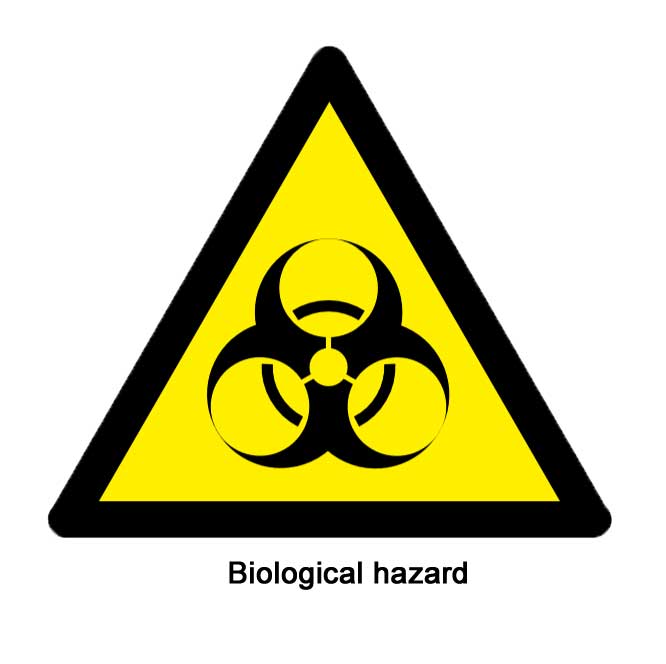 How
to request a COVID test
How
to request a COVID test You
can collect home test kits,
for example packaged as the COVID-19 Self-Test (Rapid Antigen Test) in boxes
of 7 tests, from Malvern library, the Co-op, and most pharmacies such as Boots and Murrays in Church
Street, Claremont House and Lloyds in Barnards Green, Murrays at Prospect
View, Evans and Murrays in Malvern Link, and Boots and Morrisons on the
Enigma Retail Park.
You
can collect home test kits,
for example packaged as the COVID-19 Self-Test (Rapid Antigen Test) in boxes
of 7 tests, from Malvern library, the Co-op, and most pharmacies such as Boots and Murrays in Church
Street, Claremont House and Lloyds in Barnards Green, Murrays at Prospect
View, Evans and Murrays in Malvern Link, and Boots and Morrisons on the
Enigma Retail Park.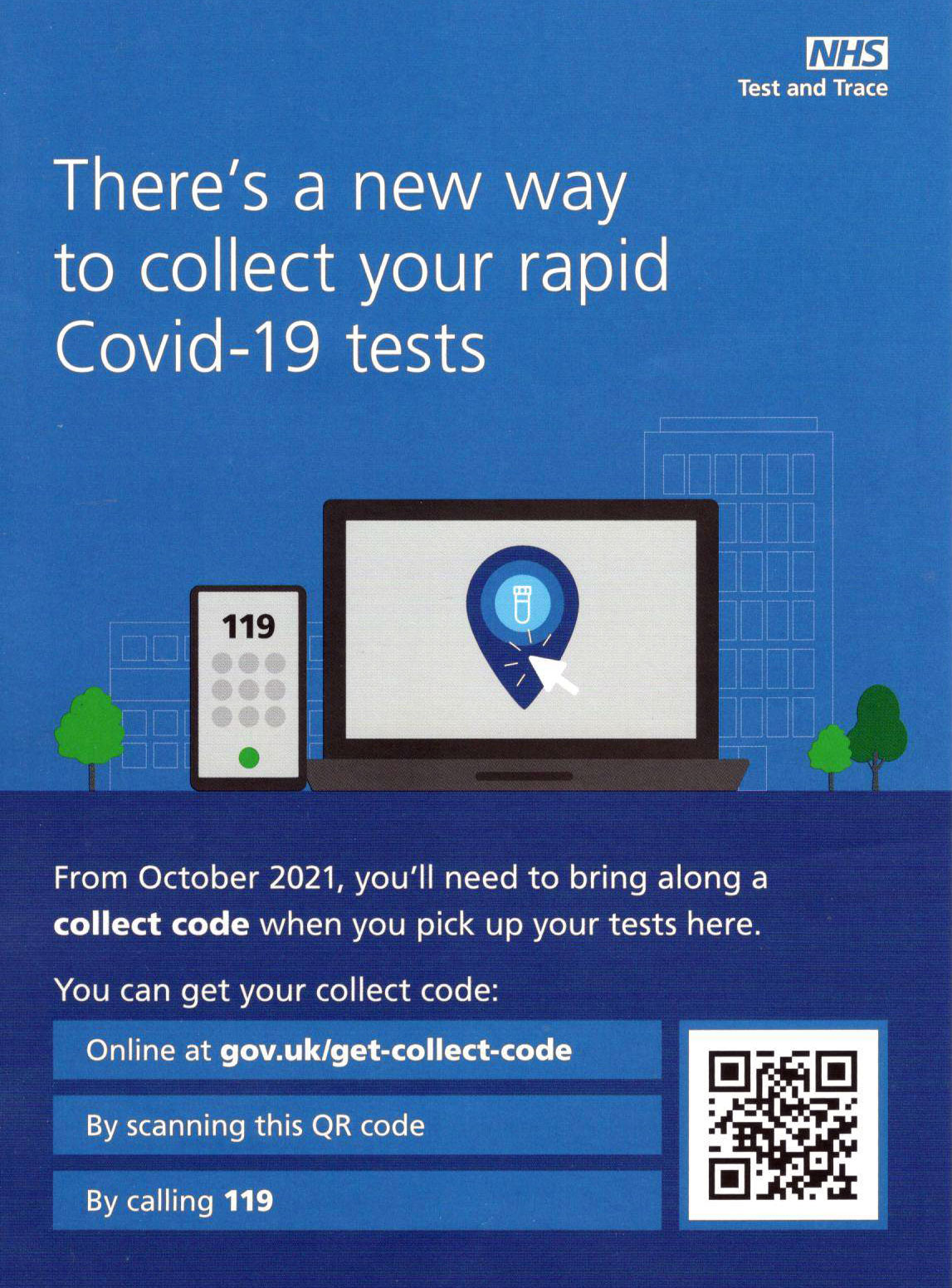
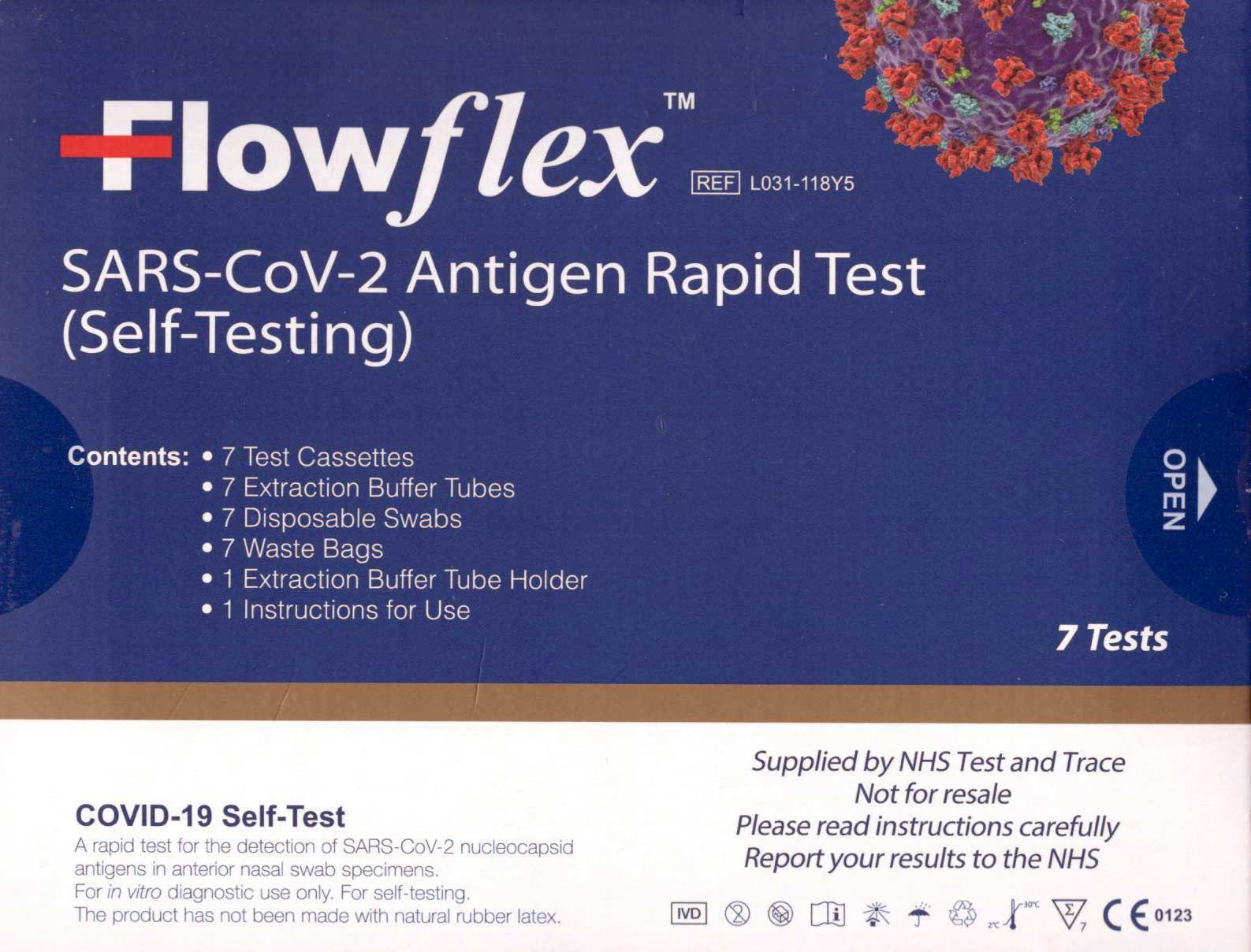
 You
can help others by downloading the COVID Symptom Study app onto your
smart-phone or Ipad and reporting how you feel either daily, or as you are
able. Note there is no desktop PC version for Windows.
You
can help others by downloading the COVID Symptom Study app onto your
smart-phone or Ipad and reporting how you feel either daily, or as you are
able. Note there is no desktop PC version for Windows.